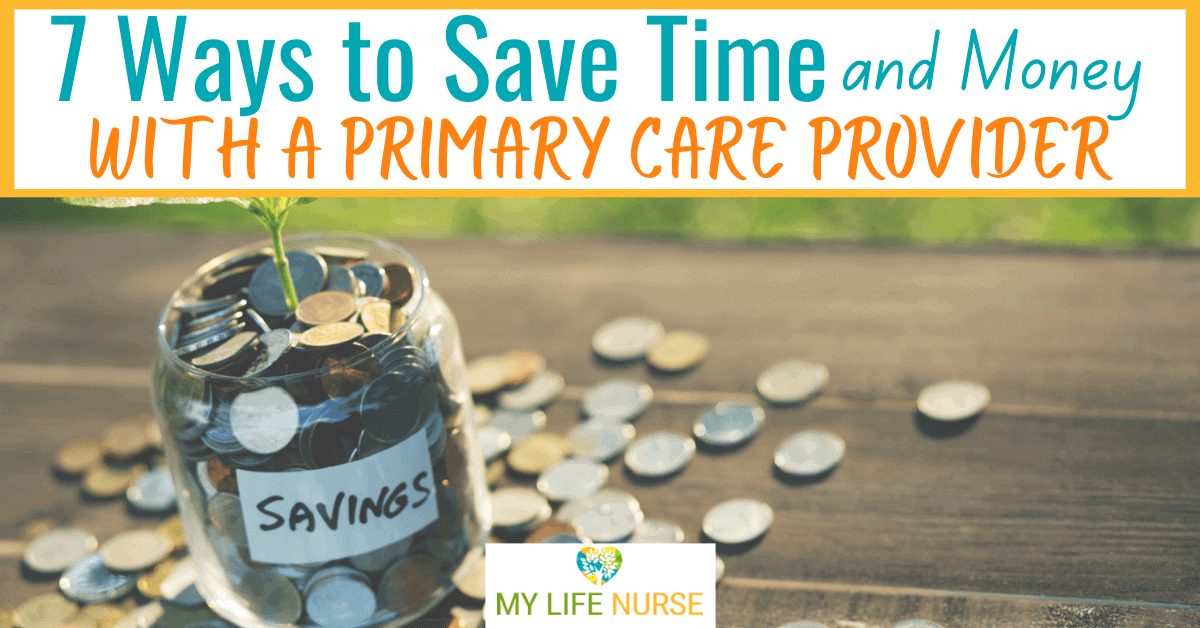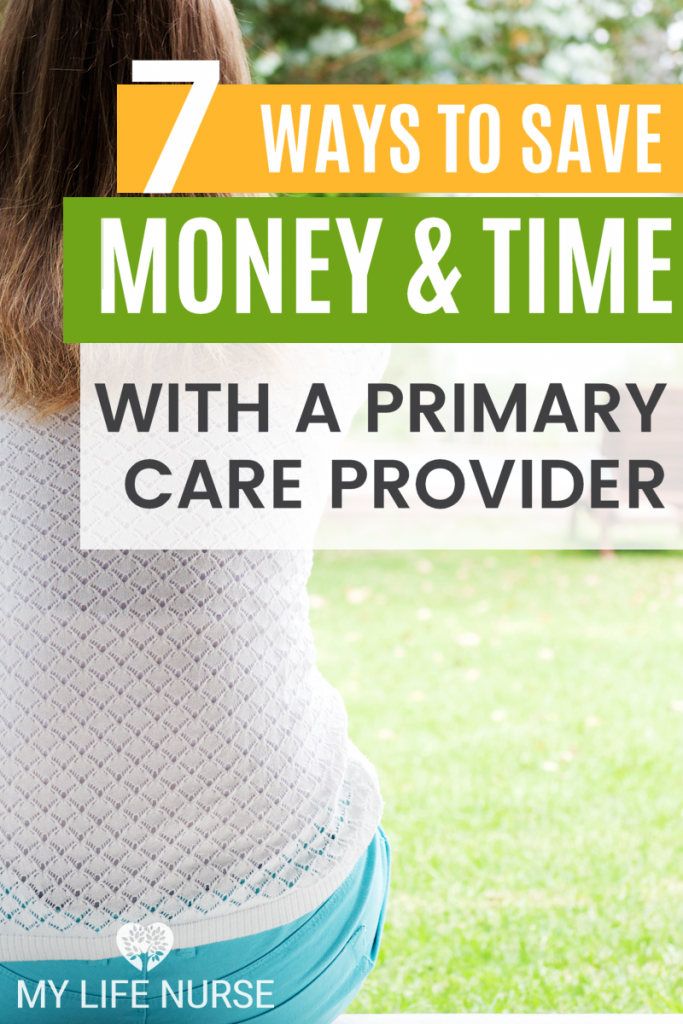Wouldn’t you love to save a little time getting healthcare services? And also save some money on your healthcare expenses this year? Rising healthcare costs have become one of the most significant expenses for families to plan for annually. Here’s the secret. Save time and money with a primary care provider (PCP).

You’ve probably noticed that healthcare costs are expensive and continuously rising. Yes, there are some services you can avoid using or use less of, and that’s true.
But in the long term, trying to prevent the use of medical services isn’t practical and can cause higher costs later.
You can avoid waste but not the need for healthcare services.
I learned a ton of tips when I worked as a nurse case manager in a primary care provider’s office. Today, I’m sharing 7 of the best ways I’ve seen to save time and money with a primary care provider.
By the way, good self-care is another way to save time and money on healthcare expenses.
But it can be overwhelming when you begin improving your self-care, and many people feel guilty when they start taking time for themselves. So, I made this free guide to help you get started. Be sure to grab yours!

If you don’t have a primary care provider, that means walk-in clinics, urgent care centers, and emergency rooms are the only other ‘quick access’ sources of healthcare services.
And depending on the day and time, availability can be a barrier.
Emergency room (ER) services are always more expensive, sometimes by hundreds or thousands of dollars, even if you have healthcare coverage.
And if you’ve ever been to an ER, you know about the long wait (which keeps getting worse!).
A simple but very real-life example: my copay for an ER visit is $500. My copay for a PCP visit is $20. Check your health benefits and copays because most health plans are set up like this.
So, the most effective way to prevent wasting your time and saving a tone of money on healthcare expenses is to establish and utilize a primary care provider to avoid using emergent providers for non-emergent care needs.
Establishing with a Primary Care Provider
You can obtain primary care services from multiple healthcare service provider types, including:
- Family practice providers
- Internists
- Pediatricians
- Nurse practitioners and physician assistants (in some more extensive and walk-in clinics)
It is essential to get established, which means to officially become one of their patients.
How do you establish with a primary care provider?
First, you need to make an appointment to see them in their clinic for an ‘establish’ visit.
Healthcare Billing Explanation
The cost of your first visit varies, but in many cases, it’s less than $100—an investment that could save you hundreds down the road.
Healthcare providers bill their services on different service levels, which are determined by the complexity and what kind of services are needed. Generally, a visit to get established is less invasive or has fewer services and, therefore, more affordable.
- Because this fee is going to vary depending on where you live, the type of doctor that you see, and the services received, you can talk to the receptionist to find out what level of service the provider typically provides and what they may be willing to forego to get you established.
- Paying for primary care provider services is more affordable if you have a robust insurance plan.
- However, getting established without insurance or having high deductible insurance coverage is still possible if you talk to the receptionist.
The Benefits of Having a Primary Care Provider
There are many perks – besides the cost-savings of establishing with a primary care provider. However the cost savings is usually quite significant.
You may even recover over a 100% return on your investment the first time you avoid using a higher costing service.
7 Ways to Save Time and Money with a Primary Care Provider:
Significantly Lower Costs
According to a study by [Source, Source], patients who use a PCP save an average of 15-33% on healthcare costs.
a. Many primary care providers (PCPs) can/will effectively treat multiple problems.
b. PCPs have high-quality outcomes without referring you to a specialist.

Geting Seen Sooner
If your need is urgent but not emergent (you do not need to be seen in an emergency room, but you should be seen soon), many clinics will do everything they can to get you into a provider.
a. For many, that can be a $25-$300 savings in copays alone!
b. And, possibly, hundreds or even thousands of dollars if you have a deductible and must pay a percent or portion of all services received.
Service Benefits (aka Your Time)After Establishing with a Primary Care Provider
There are excellent service advantages of having a PCP, for example:
Prescription Refills
You may get prescription refills without seeing the provider
a. Providers will usually renew prescriptions (if they have seen you recently/regularly).
b. Their requirement may be as infrequent as an annual visit.
c. This may come in handy if you are out of town and need a prescription refill or something.
Quicker Access to Appointments
You may also get quicker access (appointments).
Once you are an established patient, you can expect to be scheduled to see your provider within 1-2 days to a couple of weeks (depending on the illness or need).
Save Time and Money with a Primary Care Provider with 24/7 Connectivity
Another noteworthy benefit is the ‘hidden’ benefit of 24/7 connectivity.
Most primary care offices have access to after hours services through on call providers or operators.
After-Hours Care
If you require medical services after hours or on the weekend, most clinics have an after-hours phone service that may connect you to the provider on call.
The provider can help you determine whether you can wait to be seen in the clinic when it is open for business hours or need to be seen immediately at an urgent care or emergency room.
Nurse Hotline
Virtual services instead of on-site services can also save you time and money.
Some providers may use a nurse hotline.
A nurse hotline is a 24/7 service where nurses or healthcare providers are available to speak with you right then to determine if your situation should be addressed immediately or can wait until the next office day.
Typically, these decisions are made utilizing a physician-built and approved symptom triage guideline.
As a result, you have another excellent way to avoid the emergency room and feel confident that it is safe to do so!
e-Visits or Telemedicine
Some primary care providers may use e-visits or Telemedicine
Generally for these services you will complete an online e-form (listing your symptoms, history, current medications, etc.) for basic ailments (think flu, sore throats, viruses, etc.).
Then, the provider will review and offer appropriate treat. The fee for this is usually less expensive than an office visit and with zero work time missed or travel time invested.
Telemedicine uses technology to assess and treat patients.
In conclusion, using a primary care provider is a huge success because you can:
- Save valuable time
- Avoid using emergent providers for non-emergent services
- Save money on healthcare expenses
I just gave you 7 simple ways how to save time and money with a primary care provider.
But the first step is to get established.
And all it takes is making an appointment.
Call a local PCP today and book your first visit—your future self (and wallet) will thank you!
Don’t forget your FREE Self-care Starter Guide! Get it HERE.

Thanks for reading! Know someone who would benefit from reading this post? Please share it on social media!


Ready for more? Here are my latest posts!
- 10 Frugal Foods to Eat for a Healthy Pregnancy and Baby
- 9 Must-Read Blog Posts to Manage High Blood Pressure Naturally
- Overcome Self-care Barriers with 4 Easy Tips
- 4 Easy Ways to Get Your Spouse to Eat Healthy Food
- 5 Easy Ways to Find Me-Time in Your Busy Schedule
Photo Credit: Pixabay

Be sure to grab your FREE Self-care Starter Guide! Lisa Kimrey is a 33-year veteran registered nurse (RN), speaker, and author of the Bible study, The Self-care Impact: Motivation and Inspiration for Wellness. At Mylifenurse, Lisa combines her nursing expertise with Scripture-based encouragement to show readers who serve and care for others how to begin and maintain their self-care journey – without feeling guilty or overwhelmed – to feel happy, healthy, and rejuvenated.
